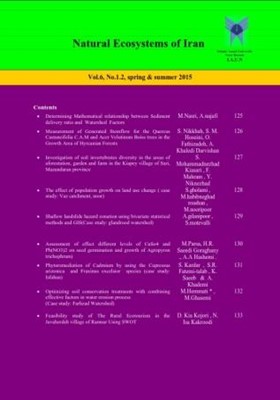Optimizing soil conservation treatments with combining effective factors in water erosion process (Case study: Farhzad Watershed)
Subject Areas : forestmohammad hemmati 1 * , mahboobeh ghasemi 2
1 - assistant professor, Department of Natural Geography, Azad University – Yadegare Emam Khomeni Rah (shahre -e- ray )Branch (Iran).
2 - دانشجوی دوره کارشناسی ارشد کاربرد ژئومرفولوژی در علوم محیطی، گروه جغرافیای طبیعی، دانشگاه آزاد اسلامی واحد یادگار امام خمینی (ره)، شهرری، تهران، ایران
Keywords: GIS, Water Erosion, Environmental crises, erosion Intensity,
Abstract :
In the recent decades, soil erosion rates in Iran have increased, so during the 1951 until now, a growth rate of 420 percent was associated with the process. Now the main problem is due to soil conservation and land management to become one of the major concerns. Most of the country's vast watershed areas and limited financial resources and administrative, are causing managers of basins for recognizing the lands with priority, looking for better planning. The models and methods that are discussed in this context is sometimes difficult because of the variety of factors and their calculation, the performance is not good, Therefore, a simpler method of acceptance is high. This study was conducted to identify the critical points of the soil erosion in the watershed Farahzad of cumulative erosion index (CEI) was used. in this method, slope land, geology and land use as the most important factors were considered in the development of water erosion. And combining them based on the GIS, the cumulative index of erosion estimation and classification, the various fields of priority areas for executive soil conservation operation in Farahzad watershed were identified and classified.
References:
1- Abdi, P., Priority and erosion potential zoning in Zanjanrod areas by using GIS, 2003, Geomatics congress, National Cartographic Center, Tehran, Iran.
2- A.Cochrane., Thomas, Filho, Celso Castro., Caviglione, João Henrique., Norton, Darrell., and Frederigi Benassi ,Simone., 2001, Identification of high risk erosion areas within the Itaipu basin by watershed modeling through RUSLE.
3- Atawoo, M, A., Heerasing . J. M.,1999, Estimation of soil erodibility and erosivity of rainfall patterns in Maurittus, agricultural research and extension unit of Australia.
4- Bhattarai, rabin., Dutta, Dushmata., 2007, Estimation of Soil Erosion and Sediment Yield Using GISat Catchment Scale, Water Resour Manage (2007) 21:1635–1647
DOI 10.1007/s11269-006-9118-z
5- Davison, P., M.G.Hutchins, S.G.Anthony, M. Betson, C.Johnson, E.I.Lord, The relationship between potentially erosive energy and daily rainfall quantity in England and Wales, Science of the Total environment 344 (2005) P 15-25.
6- FAO Farestery paper, 2006., The new generation of watershed management programs and projects, European Observatory of Mountain Forests (EOMF), International Centre for Integrated Mountain Development (ICIMOD), Red Latinoamericana de Cooperación Técnica en Manejo de Cuencas Hidrográficas (REDLACH) World Agroforestry Centre (ICRAF).
7- Gupta1, R.D., Agarwal, V.C., & Hari Kishan, G. S.,2005, Implementation of USLE Model Under GIS Environment for Soil Erosion Assessment: A Case Study of LONI River Watershed, Motilal Nehru National Institute of Technology (MNNIT), Allahabad-211004, India.
8- Morgan, R. P.C., 2005, Soil erosion and conservation, national soil resources institute, Cranfield university, Blackwell publishing, third edition, 2005, 304 Pages.
9- Ownegh., M, Nohtani, M., 2004, relathionship between geomorphology units and erosion and sediment yield in KAashidar watershed, Golestan province., IRAN.
10- SANJAY K. JAIN, SUDHIR KUMAR and JOSE VARGHESE, 2001., Estimation of Soil Erosion for a Himalayan, Watershed Using GIS Technique, Water Resources Management 15: 41–54, 2001.
11- Shadfar, S., Sobh zahedi., Sh., 2007., The investigation of Gully erosion development causes in Aliabad Gilan Basin., fourth science and watershed engineering congress, Natural resources faculty. Tehran University. Iran.
12- Studies and watersheds evaluation office in Jihad ministry, proceeding of second national congress on erosion and sediment, Ionesco national central commission in Iran, 2000, 302 p.

